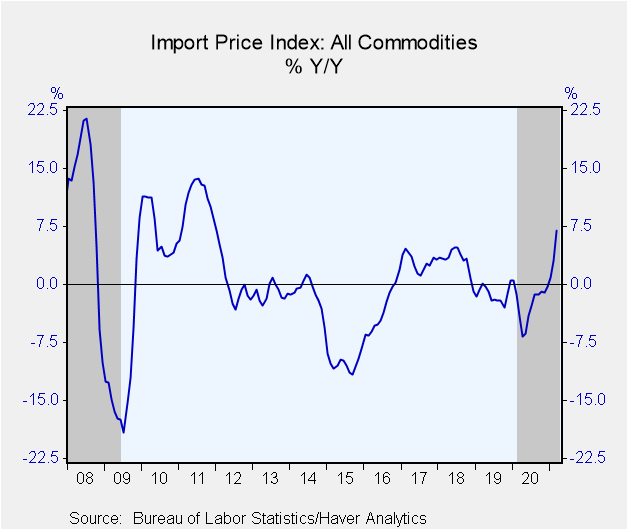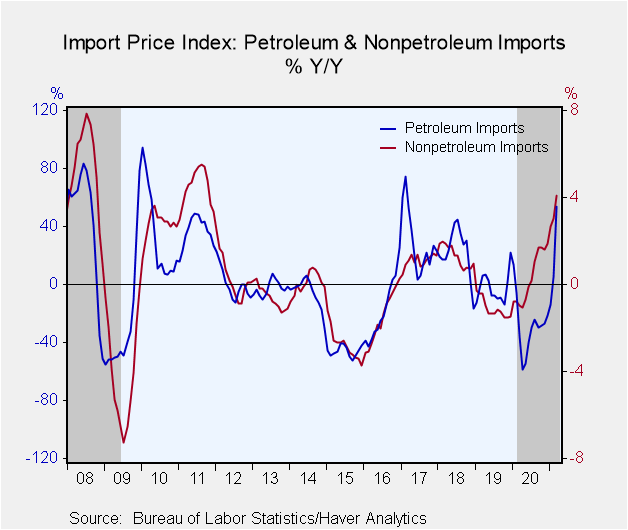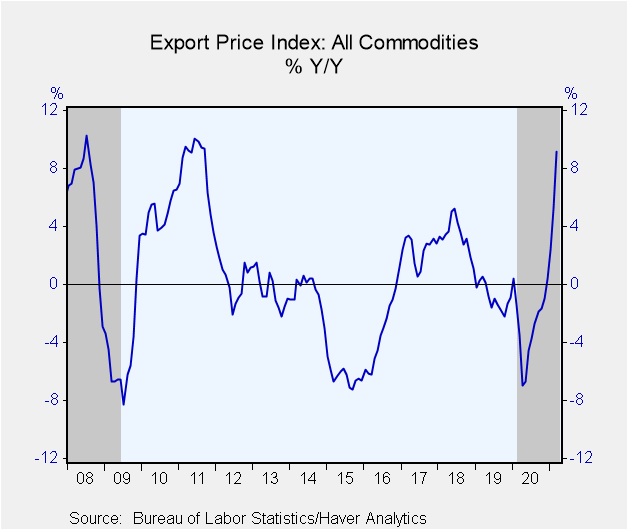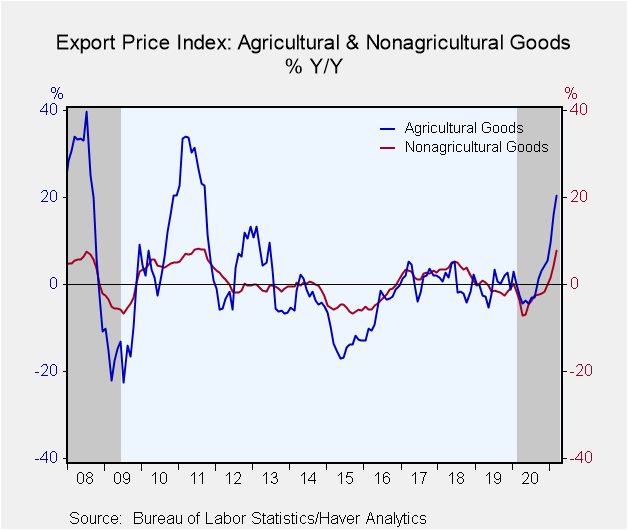 Global| Apr 14 2021
Global| Apr 14 2021U.S. Import & Export Prices Continue to Rise in March
by:Tom Moeller
|in:Economy in Brief
Summary
• Import costs are unexpectedly strong. • Export price gain picks up. Import prices increased 1.2% (6.9% y/y) during March following a 1.3% February rise. A 0.9% increase had been expected in the Action Economics Forecast Survey. [...]
• Import costs are unexpectedly strong.
• Export price gain picks up.
Import prices increased 1.2% (6.9% y/y) during March following a 1.3% February rise. A 0.9% increase had been expected in the Action Economics Forecast Survey. Price gains y/y have accelerated markedly across product categories.
A 6.7% rise (53.9% y/y) in petroleum import prices followed four months of strong increase. Nonpetroleum import costs improved 0.9% (4.1% y/y) after firm gains in each of the prior three months. Industrial supplies & materials costs rose 4.8% (29.5% y/y) led higher by the gain in fuel costs. Foods, feeds & beverages prices strengthened 2.0% (3.8% y/y), the strongest of four straight monthly gains. Capital goods prices edged 0.1% higher (1.3% y/y) as they did in February, compared to a 2.0% y/y price decline late in 2019. Nonauto consumer goods prices also rose for a second month by 0.1%. The 0.7% y/y increase was up from 0.6% y/y price deflation in March of last year. Motor vehicle & parts prices held steady, but here again the 1.1% y/y gain compares to 0.7% y/y price deflation as of late-2019.
Export prices strengthened 2.1% after three months of strong increase. The 9.1% y/y increase compared to 7.0% y/y price deflation last April. A 0.9% gain had been expected.
Agricultural prices rose 2.4% (20.5% y/y) while nonagricultural export prices strengthened 2.0% (7.9% y/y). Both y/y price increases compared to deflation in early in 2020. Industrial supplies & materials prices rose 5.0% (21.9% y/y) while foods, feeds & beverage prices improved 2.8% (20.0% y/y). Nonauto consumer goods prices gained 0.6% (0.7% y/y), the strongest m/m increase in six months. Capital goods prices improved 0.1% (0.6% y/y) following two months of 0.4% improvement. Motor vehicle & parts prices held steady but the 0.5% y/y increase compared 0.6% y/y price deflation in July of last year.
The import and export price series can be found in Haver's USECON database. Detailed figures are available in the USINT database. The expectations figure from the Action Economics Forecast Survey is in the AS1REPNA database.
| Import/Export Prices (NSA, %) | Mar | Feb | Jan | Mar Y/Y | 2020 | 2019 | 2018 |
|---|---|---|---|---|---|---|---|
| Imports - All Commodities | 1.2 | 1.3 | 1.4 | 6.9 | -2.5 | -1.3 | 3.1 |
| Petroleum | 6.7 | 11.6 | 9.3 | 53.9 | -29.4 | -2.6 | 22.0 |
| Nonpetroleum | 0.9 | 0.5 | 0.9 | 4.1 | 0.3 | -1.1 | 1.3 |
| Exports - All Commodities | 2.1 | 1.6 | 2.6 | 9.1 | -2.8 | -0.9 | 3.4 |
| Agricultural | 2.4 | 2.8 | 6.0 | 20.5 | -0.3 | -0.4 | 0.6 |
| Nonagricultural | 2.0 | 1.5 | 2.3 | 7.9 | -3.0 | -0.9 | 3.7 |
Tom Moeller
AuthorMore in Author Profile »Prior to joining Haver Analytics in 2000, Mr. Moeller worked as the Economist at Chancellor Capital Management from 1985 to 1999. There, he developed comprehensive economic forecasts and interpreted economic data for equity and fixed income portfolio managers. Also at Chancellor, Mr. Moeller worked as an equity analyst and was responsible for researching and rating companies in the economically sensitive automobile and housing industries for investment in Chancellor’s equity portfolio. Prior to joining Chancellor, Mr. Moeller was an Economist at Citibank from 1979 to 1984. He also analyzed pricing behavior in the metals industry for the Council on Wage and Price Stability in Washington, D.C. In 1999, Mr. Moeller received the award for most accurate forecast from the Forecasters' Club of New York. From 1990 to 1992 he was President of the New York Association for Business Economists. Mr. Moeller earned an M.B.A. in Finance from Fordham University, where he graduated in 1987. He holds a Bachelor of Arts in Economics from George Washington University.










